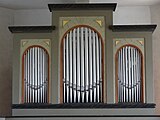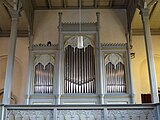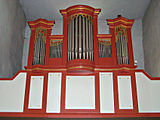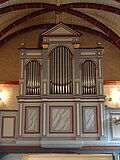Johann Georg Förster
Johann Georg Förster (born October 23, 1818 in Lich ; † December 28, 1902 in Lich) was a German organ builder and founder of the organ building company Förster & Nicolaus Orgelbau in Lich.
Life
Johann Georg Förster was the second of six children of the city shepherd Johann Konrad Förster (* 1788, † February 8, 1831) from Lich and his wife Anna Catharina born. Schneider from Steinbach (Fernwald) born. After completing an apprenticeship as a carpenter, he learned organ building from Johann Hartmann Bernhard in Romrod from his uncle Alexander Schneider . He worked as a journeyman in the Hessen-Darmstadt area with Hermann Dreymann (Mainz), Johann Georg Bürgy (Gießen) and Johann Heinrich Krämer ( Leusel ), whose daughter Katharina Elisabeth he married in 1842. A time as a journeyman with Eberhard Friedrich Walcker ( Ludwigsburg ) has not yet been proven. In the same year Förster set up his own organ building company in Lich and succeeded Bürgy, who died in 1841 without a successor. The first employee was his uncle Philipp Sebastian Förster from Lich. Most of the ten children died of tuberculosis . Only Friedrich August Leonhard Heinrich (born January 27, 1845 in Lich; † December 22, 1923 in Lich), who became a piano dealer, and his daughter Louisa (1862–1956) survived the age of 30. The son Heinrich (1852–1878) also became an organ builder, but died too young to be able to take over the company. His son of the same name (1877–1924) became an organ builder in Basel. A nephew of Johann Georg Förster by the name of Carl Förster (* December 25, 1868 in Lich; † August 20, 1934 in Alzey) took over the Landolt workshop in Heimersheim (Alzey) after he married there.
plant
Johann Georg Förster built next to mechanical slider chests and Spring store with cone valves, first for the pedal, and later for the main work. Around 1880 several instruments with a hanging valve drawer were made . Another characteristic of his style are transmission drawers with double loops. He preferred full principal choirs; even village organs are based on a principle 8 'and have a principle 16' in the pedal. The mixtures were designed individually for his roughly 90 organs with different strengths, lengths and repetitions. String parts and tongue registers are less common . The Physharmonika register with resounding tongues on its own wind chest, which has been preserved in Steinbach and Großen-Buseck, is a special feature . Förster only built one- and two-manual organs with a maximum of 25 registers. The sound was shaped by romanticism, which was dominated by fundamental voices. Förster was strongly influenced by Johann Gottlob Töpfers book Die Orgelbau-Kunst (1833). The brochures were designed by architects and building authorities.
List of works (selection)
The size of the instruments is indicated in the fifth column by the number of manuals and the number of sounding registers in the sixth column. A capital “P” stands for a separate pedal. Italics indicate that the organ in question is no longer or only the prospectus has been preserved.
| year | place | building | image | Manuals | register | Remarks |
|---|---|---|---|---|---|---|
| 1844 | Gettenau | Ev. church | I / P | 12 | completed after Bürgy's death; Slider chests; Harmonica 8 ′ is missing | |
| 1846 | Krumbach (Biebertal) | Protestant church | I / P | 7th | not received | |
| 1848 | Friedberg | Castle Church | I / P | 12 | 1889 extension conversion by Johann Georg Förster | |
| 1849 | Steinbach (Fernwald) | Protestant church | II / P | 24 | New building, with slider drawer; Almost completely preserved, in 1870 viol replaced by Förster, in 1873 physharmonica added | |
| 1852 | Eberstadt (Lich) | Protestant church |

|
I / P | 8th | Get prospectus; behind it new factory of the Oberlinger workshop with its own brochure |
| 1854 | Kaichen | Ev. church | I / P | 12 | largely preserved; Reconstructed to its original state | |
| 1854 | Bettenhausen (Lich) | Evangelical Reformed Church | I / P | 10 | Cone shop; almost completely preserved | |
| 1858 | Maar (Lauterbach) | Ev. church | II / P | 22nd | Valve spring loading | |
| 1863 | Albach (Fernwald) | Protestant church |

|
I / P | 8th | completely preserved |
| 1864 | Butzbach | Wendelin Chapel | I / P | 8th | ||
| 1865 | Langd | Protestant church |

|
II / P | 12 | receive |
| 1868 | Bellersheim | Protestant church |

|
II / P | 15th | Jumping wind shop; completely preserved |
| 1870 | Grossen-Buseck | Protestant church | II / P | 20th | New building with cone shop; largely preserved, with physharmonica and collective step (fixed combination ) | |
| 1872 | Langsdorf (Lich) | Evangelical Reformed Church | II / P | 13 | Replaced in 1925 by a new building by Förster & Nicolaus | |
| 1873 | Queckborn | Protestant church |

|
I / P | 8 (9) | receive |
| 1878 | Hunger | Evangelical town church | II / P | 25th | Förster's largest organ, mechanical cone chests; not received | |
| 1879 | Allendorf / Lahn | Protestant church |

|
I / P | 7th | almost completely preserved |
| 1880 | Ettingshausen | Protestant church | I / P | 8th | mechanical cone shop; receive | |
| 1880-1881 | Annerod | Protestant church |

|
II / P | 14th | Hanging valve drawer, transmission drawer |
| 1885 | Nonnenroth | Evangelical Reformed Church |

|
I / P | 9 | receive |
| 1886 | Oppenrod | Protestant church |

|
I / P | 7th | receive |
| 1889 | Sellnrod | Half-timbered church |

|
I / P | 8th | receive |
| 1890 | Watzenborn-Steinberg | Old church | I / P | 8th | Expanded and stored in 2008 | |
| 1893 | Bingenheim | Protestant church |

|
II / P | 12 | mechanical cone shop; preserved unchanged |
| 1896 | Hausen (Pohlheim) | Protestant church | I / P | 7th | Replaced in 1974 by a new building by Förster & Nicolaus, including some old registers | |
| 1897 | Frischborn | Ev. church | II / P | 14th | "Lappen wind chests" with tube pneumatics | |
| 1899 | Alten-Buseck | Protestant church | II / P | 10 | pneumatic cone store, neo-renaissance style prospectus | |
| 1899 | Reiskirchen | Protestant church |

|
II / P | 9 | receive |
| 1899 | Muschenheim | Protestant church | II / P | 9 | Replaced in 1992 | |
| 1900 | Sheaf pond | Protestant church | I / P | 9 | Replaced in 1974 by a new building by Förster & Nicolaus, including some old registers |
literature
- Hans Martin Balz : 175 years of Förster & Nicolaus. In: Ars Organi . 65, 2017, pp. 7-16.
- Hans Martin Balz: organs and organ builder in the area of the former Hessian province of Starkenburg. A contribution to the history of organ building (= studies on Hessian music history. 3). Görich & Weiershäuser, Marburg 1969.
- Franz Bösken : Förster and Nicolaus . In: Music in the past and present . Vol. 16. Bärenreiter, Kassel 1979, ISBN 3-89853-160-0 , pp. 319-320 (CD-Rom edition of the 1st edition, Directmedia, Berlin 2003).
- Franz Bösken: Sources and research on the organ history of the Middle Rhine (= contributions to the Middle Rhine music history . Volume 7.2 ). tape 2 : The area of the former administrative district of Wiesbaden. Part 2: L-Z . Schott, Mainz 1975, ISBN 3-7957-1370-6 .
- Hans-Joachim Falkenberg: Epochs in the history of the organ. Förster and Nicolaus 1842–1992. Organ building specialist publisher Rensch, Lauffen 1992, ISBN 3-921848-24-5 .
- Hermann Fischer : 100 years of the Association of German Organ Builders. Orgelbau-Fachverlag, Lauffen 1991, ISBN 3-921848-18-0 , pp. 185-186.
Web links
Individual evidence
- ^ Falkenberg: Epochs of Organ History. 1992, p. 15.
- ^ Balz: 175 years of Förster & Nicolaus. 2017, p. 7.
- ↑ Hermann Fischer: 100 Years of the Association of German Organ Builders . Orgelbau-Fachverlag, Lauffen 1991, ISBN 3-921848-18-0 , p. 185.
- ^ Falkenberg: Epochs of Organ History. 1992, p. 21.
- ↑ a b Balz: 175 years of Förster & Nicolaus. 2017, p. 11.
- ^ Franz Bösken: Förster and Nicolaus . In: Music in the past and present . Vol. 16. Bärenreiter, Kassel 1979, ISBN 3-89853-160-0 , p. 319.
- ^ Falkenberg: Epochs of Organ History. 1992, pp. 31-32.
- ^ Balz: 175 years of Förster & Nicolaus. 2017, p. 9.
- ^ Organ in Kaichen , accessed on April 17, 2018.
- ^ Bösken, Fischer: Sources and research on the organ history of the Middle Rhine. Vol. 3, Part 1: A – L. 1988, p. 551.
| personal data | |
|---|---|
| SURNAME | Forester, Johann Georg |
| BRIEF DESCRIPTION | German organ builder |
| DATE OF BIRTH | October 23, 1818 |
| PLACE OF BIRTH | Lich |
| DATE OF DEATH | December 28, 1902 |
| Place of death | Lich |







